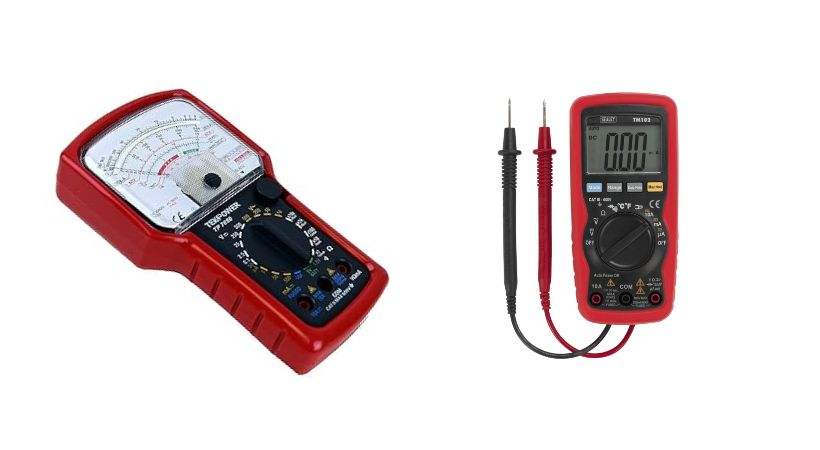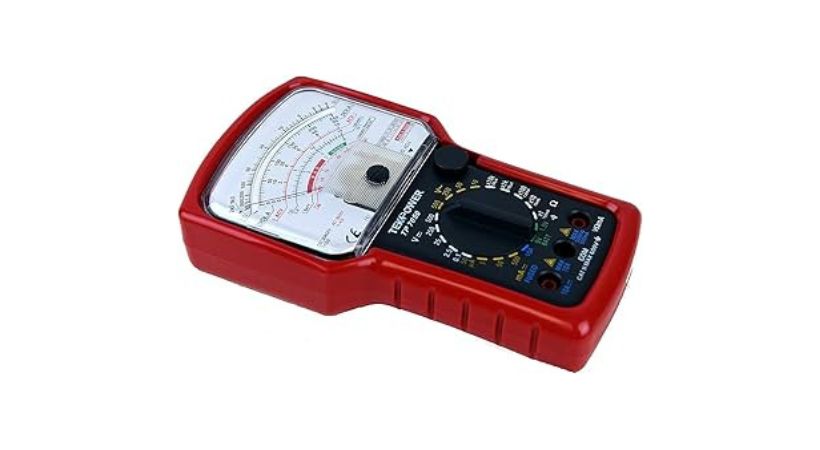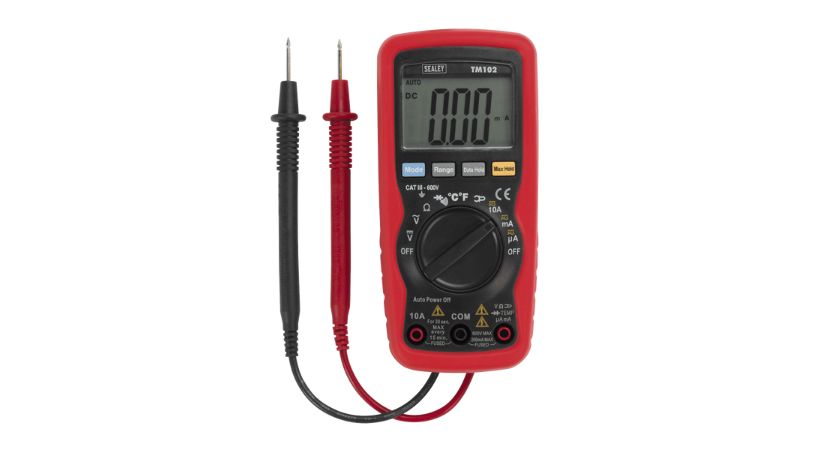Types of multimeters (Analog and Digital, 2025)
From basic household troubleshooting to complex engineering tasks, multimeters come in different types, each with unique features and advantages.
There are basic two types of multimeter: Analog and Digital multimeter. The analog multimeter has a mechanical movement, typically a moving coil meter, to display measurements on a scale using a needle. On the other hand, the digital multimeter has an LCD that shows the measured results in numeric values. The smart and programmable multimeters are the advanced version of the multimeter. Each type has distinct applications.
In this article, we’ll talk about types of multimeters and their characteristics, applications, and benefits.
Multimeter types
A multimeter, short for “multiple meters” or “multi-tester,” is an electronic instrument used to measure multiple electrical quantities in a circuit.
It’s an essential tool for anyone working with electrical systems, including electricians, electronics technicians, engineers, hobbyists, and students.

Multimeters are versatile and can measure various parameters, including voltage, current, resistance, continuity, capacitance, and sometimes temperature.
It is composed of different components such as a display, selection dial, input jacks, and testing probes.
The display shows the measured result, the selection dial allows the user to select the measuring mode and test probes are the wires or cables that connect the multimeter to the circuit being measured.
Multimeters come in various types, each suited for specific applications and user preferences.
If you want to learn more about multimeters, see our article:
Let’s talk about each type in detail for your better understanding.
1. Analog multimeter
Analog multimeters, also known as analogue multimeters, are used in electronics to measure different electrical parameters.

They have been widely used for many years due to their simple design, durability, and ease of use features. The analog multimeter works on a moving coil mechanism.
Analog multimeter working
The analog multimeter has construction components like a moving coil, selector switch, scale, and input jack.
The moving coil is responsible for the measurements. The coil is suspended within a magnetic field. When current flows through the coil, it experiences a torque that causes it to move, deflecting a needle attached to it.
The selector switch allows the user to select the measuring mode that you want to measure. The scale is for result display and input jacks where test leads or probes are connected for making measurements.
You have to rotate the selector switch and select the mode. For example, you selected the voltage measurement mode.
When measuring voltage, the multimeter is connected in parallel with the circuit or component under test. The voltage causes current to flow through the moving coil, deflecting the needle on the scale to indicate the voltage value.
During the current measurement, you must connect this meter in series with the circuit. This was a simple explanation of how an analog multimeter works.
Advantages of analog multimeter
Let’s discuss some advantages that made the analog multimeter to be used for decades.
- Analog multimeters are straightforward to use and understand, making them suitable for beginners and educational purposes.
- Due to their mechanical construction, analog multimeters are often more robust and resistant to damage from voltage spikes or accidental drops compared to digital multimeters.
- Analog multimeters provide instantaneous readings that respond quickly to changes in the measured quantity.
- Analog multimeters are generally less expensive than their digital counterparts, making them accessible to users on a budget.
Disadvantages of analog multimeter
Here are the drawbacks of analog multimeters which make the need for more advanced multimeters possible.
- Analog multimeters typically have lower accuracy and resolution compared to digital multimeters, especially for precise measurements or small signal levels.
- The measuring scale of the analog multimeter is one of the basic disadvantages. Wrong interpretation may lead to incorrect measurements.
- Reading the scale on an analog multimeter requires precise alignment of the eye with the pointer, and can affect measurement accuracy.
- Analog multimeters require manual selection of measurement ranges, which can be cumbersome and may lead to incorrect readings if the wrong range is chosen.
Analog multimeters are simple, reliable instruments for basic electrical measurements. However, it has some limitations in terms of accuracy and resolution.
2. Digital multimeter
Digital multimeters (DMMs) are sophisticated electronic instruments designed for accurate measurement of various electrical parameters.

In a digital multimeter, we don’t have to see the scale and interpret the measurement, now we have a display that shows the result in numeric values.
The construction of a digital multimeter is a little bit different from analog multimeter. Let us delve into a detailed discussion of digital multimeters.
Digital multimeter working
The digital multimeter is constructed with components such as a display, microcontroller or processor, display, selector dial, analog-to-digital converter (ADC), and input section.
The microcontrollers or processors are responsible for controlling the measurement process, processing data, and controlling the display and ADC converts the analog signal to digital.
The display, where measurement values are shown numerically. DMMs feature a digital display, typically an LCD (Liquid Crystal Display) or LED (Light Emitting Diode) screen.
The selector dial allows users to select the desired measurement function (voltage, current, resistance, etc.) and range. The input section includes input jacks where test leads or probes are connected to the multimeter.
The operation of a digital multimeter involves, you have to connect the probes of the multimeter to the circuit and set to the desired measurement function (voltage, current, resistance, etc.) using a selector dial.
Now the multimeter applies a known reference voltage or current to the input circuit and measures the resulting signal. The resulting signal is analog, now the ADC converts that signal into digital.
The digital signal is processed by the microcontroller or processor to perform any necessary calculations, such as scaling, offset adjustment, or unit conversion.
After the processing, the measured data is displayed on the digital screen in numerical form.
Advantages of digital multimeter
Here are some advantages of digital multimeter.
- Digital multimeters offer higher accuracy and resolution compared to analog multimeters, making them suitable for precise measurements.
- It can measure multiple parameters providing versatility for different testing scenarios.
- The digital display is one of the key advantages of digital multimeters because the numerical display of DMMs is easier to read and interpret compared to analog needles.
- Many digital multimeters feature auto-ranging capability, which automatically selects the appropriate measurement range.
- Digital multimeters often come with additional features such as data logging, min/max recording, peak hold, relative measurement, and connectivity options for remote monitoring and control.
Disadvantages of digital multimeter
Every good thing also has bad sides, the same is true for digital multimeters.
These are the digital multimeter drawbacks.
- Digital multimeters are typically more expensive than analog multimeters due to their advanced electronics and features.
- Digital multimeters have a complex design, especially for beginners, due to their multiple functions, buttons, and menu options.
- DMMs rely on batteries for power, which need to be replaced or recharged periodically.
- Digital multimeters may be more susceptible to electrical noise and interference compared to analog multimeters.
Want to buy digital multimeter, here is our article:
3. Programmable multimeter
One type of multimeter is a programmable multimeter. Most of the benchtop multimeters are programmable multimeters.

It allows the user to test your system by providing various testing conditions. The construction and working of the programmable multimeter is different from analog and digital multimeter.
Programmable multimeter working
Programmable multimeters include an ADC to convert analog signals, input jacks for connecting test leads or probes, microcontrollers or processors that control the measurement, and standard programming languages.
The working principle is the same as the digital multimeter but it depends upon your commands.
The user connects the test leads or probes to the circuit or component being measured and selects the desired measurement function and range on the multimeter.
The multimeter measures the analog signal and converts it into digital using ADC. After some processing, the result is on the screen.
Advantages of programmable multimeter
Some benefits of programmable multimeters are discussed below.
- Programmable multimeters offer extensive customization options, allowing users to define custom measurement functions.
- Programmable multimeters can measure multiple parameters and perform advanced functions beyond basic measurements, such as data logging, statistical analysis, and signal processing.
- Many programmable multimeters support remote control and monitoring via communication interfaces, allowing users to control the multimeter.
- They are suitable for laboratory work and high-voltage applications.
- Programmable multimeters enable the automation of measurement processes, facilitating integration into research setups, and industrial applications.
Disadvantages of programmable multimeters
Here are the disadvantages of a programmable multimeter.
- Programmable multimeters have advanced features and customization options. Users may require training or experience to fully utilize their capabilities.
- They are more expensive than basic multimeters due to their advanced features.
- Some programmable multimeters may have higher power consumption, especially when performing complex measurements.
Conclusion
A multimeter is a tool that makes our measurement process easy during working with different electronic components.
It offers different measurement options to make sure the components we are working with are not faulty and will function properly when connected to the circuit.
The multimeter comes in various types but the three main types are analog, digital, and programmable multimeter.
The analog multimeter is the type of multimeter in which scale and needle are used to show results and it works on the current carry coil. The display of this multimeter is its biggest drawback.
The multimeters that show the result on the screen in numeric form are digital. These are some of the most commonly used multimeters and are very beginner-friendly.
The programmable multimeters are benchtop multimeters and provide a wide range of measurement capabilities.
This was all about the types of multimeter, I hope it will be helpful.
Thank you and stay blessed.
Other useful posts:
